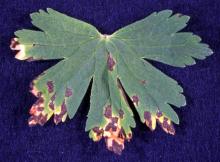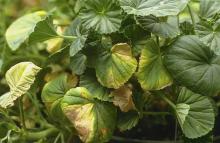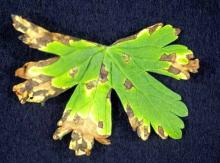See:
Poinsettia (Euphorbia pulcherrima) - Bacterial Leaf Spot
Cause Xanthomonas hortorum pv. pelargonii (formerly X. campestris pv. pelargoni), a bacterium. Other Xanthomonas spp. can also cause similar but less severe symptoms including X. codiaei and X. axonopodis pv. poinsettiaecola. These bacteria can survive in association with plant debris in the soil for 6 months or more depending on the rate of plant decomposition. Bacteria cannot survive in association with plant debris in the soil after the plant debris decomposes. Bacteria are readily spread by physical contact, irrigation water, rain, tools, and insects but are not contained in seed. Seedling geraniums are susceptible but are free of the disease unless grown in close proximity to vegetatively-propagated plants. The pathogen enters leaf hydathodes when splash dispersed and then moves into the rest of the plant through the vascular system. Infected plants may remain symptomless at cool temperatures until warm conditions return. Some cultivars of regal or Martha Washington geraniums are very resistant, but leaf spots have been observed. Hardy, perennial geraniums can be non-symptomatic carriers of the bacteria. Sources of bacteria may include poinsettia, croton (Codiaeum variegatum), crown of thorns (Euphorbia milli) and zebra plant (Aphelandra squarrosa).
Symptoms Cuttings-sudden black rotting that starts at the base of the cutting. Cuttings usually fail to root.
Stem-blue-black rotting on parts of stems. Leaves drop, then stems partially recover and produce new leaves at the terminals. In the case of Verticillium stem dieback, affected stems do not recover. The two diseases are easily confused.
Leaf-depending on the cultivar affected, symptoms are either round spots or angular, sometimes V-shaped, dead areas. Spots may initially appear as small translucent pustules similar to those, which are characteristic of oedema. Round spots are dark green to black, about 0.0625 to 0.125 inch wide, and slightly sunken. Affected leaves wilt and die; leaves may stay on the plant for some time afterward. Angular, dead areas occur when sectors of leaves bounded by the veins die. This symptom is accompanied by a wilting of leaf edges. Bacteria from leaf spots may spread down the petiole, into the stem, then back to the top of the plant. Ivy geranium foliage loses luster and develops symptoms suggesting nutrient deficiency or mite infestation.
Cultural control Prevention is the key because once the disease gets in a crop then destruction of infected plants, as well as the plants adjacent to those infected plants, is the only practical control.
- Grow plants from seed.
- Use bacteria-tested (and found to be free of all known bacteria) certified stock plants. Vascular-inhabiting bacteria are carried over in cuttings from symptomless infected plants, from obviously diseased plants, or from recently infested soil.
- Insist that workers not handle Pelargonium or Geranium spp. in other locations before working in the greenhouse. Have them wash their hands if they do.
- Do not grow geraniums around or near the greenhouse production area.
- Set out stock in sterilized soil or soilless planting media.
- Prevent contaminating stock plants by disinfecting cutting knives and other tools frequently. Soak tools 60 sec in 10% bleach (Clorox) or shellac thinner (70% ethyl alcohol) or quaternary ammonium (Physan 20).
- Keep plants from different propagators separate, as an outbreak may be confined to only one source.
- Prevent or minimize splashing when watering plants. Do not overhead irrigate unless conditions promote rapid drying.
- Use no more than 63°F bottom heat. Do not use bottom heat for pelargoniums.
- Do not put ivy geraniums in hanging baskets over geraniums on the bench.
- Scout often for early detection. Remove and test any plants that look suspect.
- Carefully remove and discard any symptomatic plants or those that test positive for the bacteria. Also remove and discard adjacent plants.
- Discard all remaining geraniums at the end of the production cycle and keep greenhouse free of geraniums for as long as possible before resuming geranium production.
- There are differences in cultivar reaction so select ones that are more resistant.
Chemical control Focus efforts primarily on cultural controls. Applying copper-containing materials (Group M1 fungicides) sometimes induces rapid yellowing of infected plants. Such plants are then more easily identified and discarded.
- Agri-Mycin 50 at 5.3 to 16 oz/100 to 300 gal water/A. Tolerant strains of the bacterium easily develop with repeated use of this product. Alternate with other bactericides to prevent or delay buildup of tolerant strains. Group 25 fungicide. 12-hr reentry.
- Badge X2 at 1.5 to 2 lb/A. Group M1 fungicide. 24-hr greenhouse reentry. O
- CuPRO 5000 at 1.5 to 2 lb/A. Group M1 fungicide. 48-hr reentry.
- FireWall 50 WP at 1.36 oz/25 gal water. Group 25 fungicide. 12-hr reentry.
- Grotto at 0.5 to 2 gal/30 to 100 gal water/A. Group M1 fungicide. 4-hr reentry.
- Junction at 1.5 to 3 lb/A. Spray solution pH should be above 6.5. Group M1 + M3 fungicide. 48-hr reentry.
- Kalmor at 1 lb/100 gal water. Group M1 fungicide. 24-hr reentry. O
- KleenGrow at 6 to 38 fl oz/100 gal water. 48-hr reentry.
- Monterey Liqui-Cop at 3 Tbsp/gal water. H
- Nu-Cop 50 DF at 1 lb/100 gal water. Group M1 fungicide. 48-hr reentry. O
- Phyton 27 at 1.5 to 5 oz/10 gal water. Higher rates may cause severe leaf burns and/or yellowing of infected plants prior to symptom development. Group M1 fungicide. 48-hr reentry.
Biological control May provide some benefit.
- Cease or Rhapsody (Bacillus subtilis strain QST 713) at 8 quarts/100 gal water. Active ingredient is a small protein. Variable results but was useful in some California and Georgia trials. 4-hr reentry. O
- Triathlon BA (Bacillus amyloliquefaciens strain D747) at 6 quarts/100 gal water. Group BM02 fungicide. 4-hr reentry. O
References Nameth, S.T., Daughtrey, M.L., Moorman, G.W., and Sulzinski, M.A. 1999. Bacterial blight of geranium: A history of diagnostic challenges. Plant Disease. 83:204-211.
Rockey, W., Potnis, N., Timilsina, S., Hong, J.C., Vallad, G.E., Jones, J.B., and Norman, D.J. 2015. Multilocus sequence analysis reveals genetic diversity in xanthomonads associated with poinsettia production. Plant Disease. 99:874-882.




